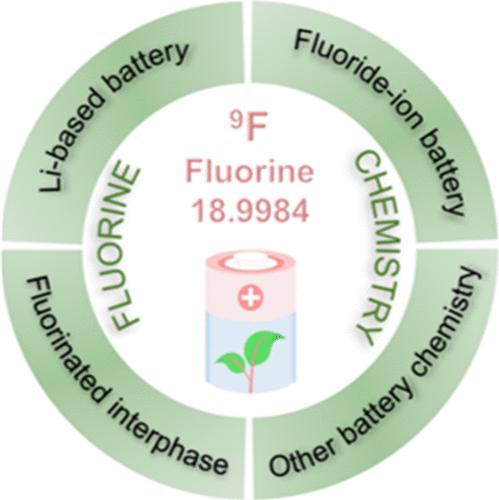当前位置:
X-MOL 学术
›
Chem. Rev.
›
论文详情
Our official English website, www.x-mol.net, welcomes your feedback! (Note: you will need to create a separate account there.)
Fluorine Chemistry in Rechargeable Batteries: Challenges, Progress, and Perspectives
Chemical Reviews ( IF 62.1 ) Pub Date : 2024-03-13 , DOI: 10.1021/acs.chemrev.3c00826 Yao Wang 1 , Xu Yang 2 , Yuefeng Meng 1 , Zuxin Wen 1 , Ran Han 1 , Xia Hu 1 , Bing Sun 2 , Feiyu Kang 1 , Baohua Li 1 , Dong Zhou 1 , Chunsheng Wang 3 , Guoxiu Wang 2
Chemical Reviews ( IF 62.1 ) Pub Date : 2024-03-13 , DOI: 10.1021/acs.chemrev.3c00826 Yao Wang 1 , Xu Yang 2 , Yuefeng Meng 1 , Zuxin Wen 1 , Ran Han 1 , Xia Hu 1 , Bing Sun 2 , Feiyu Kang 1 , Baohua Li 1 , Dong Zhou 1 , Chunsheng Wang 3 , Guoxiu Wang 2
Affiliation

|
The renewable energy industry demands rechargeable batteries that can be manufactured at low cost using abundant resources while offering high energy density, good safety, wide operating temperature windows, and long lifespans. Utilizing fluorine chemistry to redesign battery configurations/components is considered a critical strategy to fulfill these requirements due to the natural abundance, robust bond strength, and extraordinary electronegativity of fluorine and the high free energy of fluoride formation, which enables the fluorinated components with cost effectiveness, nonflammability, and intrinsic stability. In particular, fluorinated materials and electrode|electrolyte interphases have been demonstrated to significantly affect reaction reversibility/kinetics, safety, and temperature tolerance of rechargeable batteries. However, the underlining principles governing material design and the mechanistic insights of interphases at the atomic level have been largely overlooked. This review covers a wide range of topics from the exploration of fluorine-containing electrodes, fluorinated electrolyte constituents, and other fluorinated battery components for metal-ion shuttle batteries to constructing fluoride-ion batteries, dual-ion batteries, and other new chemistries. In doing so, this review aims to provide a comprehensive understanding of the structure–property interactions, the features of fluorinated interphases, and cutting-edge techniques for elucidating the role of fluorine chemistry in rechargeable batteries. Further, we present current challenges and promising strategies for employing fluorine chemistry, aiming to advance the electrochemical performance, wide temperature operation, and safety attributes of rechargeable batteries.
中文翻译:

可充电电池中的氟化学:挑战、进展和前景
可再生能源行业需要可利用丰富的资源以低成本制造的可充电电池,同时提供高能量密度、良好的安全性、宽工作温度范围和长使用寿命。利用氟化学重新设计电池配置/组件被认为是满足这些要求的关键策略,因为氟的天然丰度、强大的结合强度和非凡的电负性以及氟化物形成的高自由能,使得氟化组件具有成本效益、不可燃性和内在稳定性。特别是,氟化材料和电极/电解质界面已被证明显着影响可充电电池的反应可逆性/动力学、安全性和耐温性。然而,控制材料设计的基本原则和原子水平上界面的机械见解在很大程度上被忽视了。本综述涵盖了广泛的主题,从探索金属离子穿梭电池的含氟电极、氟化电解质成分和其他氟化电池组件,到构建氟离子电池、双离子电池和其他新化学物质。在此过程中,本综述旨在全面了解结构-性能相互作用、氟化中间相的特征以及阐明氟化学在可充电电池中的作用的尖端技术。此外,我们提出了采用氟化学的当前挑战和有前途的策略,旨在提高可充电电池的电化学性能、宽温度操作和安全属性。
更新日期:2024-03-13
中文翻译:

可充电电池中的氟化学:挑战、进展和前景
可再生能源行业需要可利用丰富的资源以低成本制造的可充电电池,同时提供高能量密度、良好的安全性、宽工作温度范围和长使用寿命。利用氟化学重新设计电池配置/组件被认为是满足这些要求的关键策略,因为氟的天然丰度、强大的结合强度和非凡的电负性以及氟化物形成的高自由能,使得氟化组件具有成本效益、不可燃性和内在稳定性。特别是,氟化材料和电极/电解质界面已被证明显着影响可充电电池的反应可逆性/动力学、安全性和耐温性。然而,控制材料设计的基本原则和原子水平上界面的机械见解在很大程度上被忽视了。本综述涵盖了广泛的主题,从探索金属离子穿梭电池的含氟电极、氟化电解质成分和其他氟化电池组件,到构建氟离子电池、双离子电池和其他新化学物质。在此过程中,本综述旨在全面了解结构-性能相互作用、氟化中间相的特征以及阐明氟化学在可充电电池中的作用的尖端技术。此外,我们提出了采用氟化学的当前挑战和有前途的策略,旨在提高可充电电池的电化学性能、宽温度操作和安全属性。
































 京公网安备 11010802027423号
京公网安备 11010802027423号